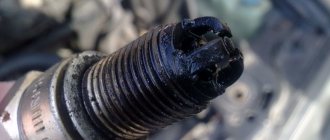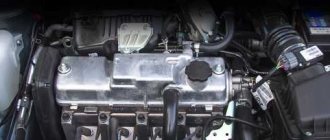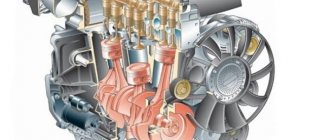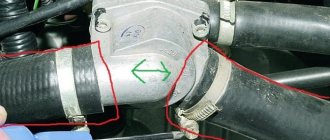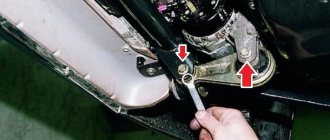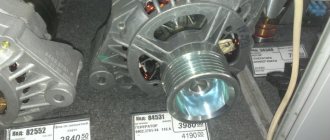What is engine life
Each machine has a device that determines its movement. This power unit is called an engine. In turn, each motor has a certain operating life, during which no intervention in its design is required. In mechanics, this concept has a precise name - engine life.
In other words, the resource is the mileage before the onset of repair work related to the dismantling of the crankshaft of the unit. The limiting state is determined by a drop in engine power, the appearance of uncharacteristic noise during its operation (knocking, creaking, etc.) or an increase in oil and fuel consumption.
In most cases, the condition of the engine is not related to mileage. The main factors influencing the reliability of its operation are operating conditions and workmanship. An engine operated in compliance with the rules can travel hundreds of thousands of kilometers without repair.
The engines installed on the Lada Grant belong to a new generation of power units that are successfully used by domestic models. These are engines 11183 in the standard configuration, 11186/21116 in the standard configuration, and 21116 in the luxury configuration. Each of them has its own characteristics and characteristics, which need to be considered in more detail.
Engine characteristics Grants
The VAZ 11183 engine was first used for installation on the Lada Kalina. This is a four-cylinder device with 8 valves and a volume of 1.6 liters. Structurally, this power unit is almost no different from the 21114 engine, widely used by the manufacturer on its models, starting with the VAZ-2109 and ending with modifications of the Kalina.
According to experts, both 11183 and 21114 have the same parameters and characteristics of all parts of the engine: block, camshaft, head, valves, crank mechanism, etc. That is, in fact, these are the same engine with different names .
11183 is characterized by increased environmental friendliness, reliability and increased volume. The timing drive is a belt drive, located in such a way that a broken belt does not bend the valves. This is also facilitated by deep piston recesses.
According to the plant, the service life of 21114 does not exceed 150 thousand km, but in practice the engine has successfully covered a mileage of 200 thousand. The service life of 11183 officially has an indicator of 200 thousand km.
Design Features
The main feature of this engine was the replacement of the piston part from an American manufacturer with pistons from a Russian company. The VAZ engine markings have also changed.
Engine 11186 adopted the design base from engine 21114. When the belt breaks, the piston of the VAZ engine of this model bends the valve. This must be taken into account and carefully monitor the appearance of cracks on the belt. However, they began to make this spare part of the motor durable, so there is a possibility that the belt will survive with the motor until a major overhaul.
I provided a description of the full technical characteristics above. Now I will talk about the oils that need to be poured into the engine so that it does not seize.
- all-season vehicles for all regions of the Russian Federation. Namely 10W40, 5W40, 15W30;
- Mineral based oil is not recommended. Semi-synthetic is allowed, but it is better to use a synthetic lubricant;
- Oils from the following companies are suitable for filling: Lukoil, Rosneft, Mobil, Zic.
To reduce overheating of the VAZ engine, nozzles were used that inject oil onto the surface of the valves. This prevents lubricant from entering the crankcase and causing gasket wear.
The piston skirt, compared to the skirt on other engines, was made lighter by being reduced in size. The engine size was increased, but not by much. A modern E-gas throttle valve is installed.
Similar article Characteristics and maintenance of the 1KR FE engine
All these innovations made it possible to increase the power of the VAZ engine, increase its reliability and raise the engine’s environmental class to Euro 4. To prevent the belt from breaking the valve if it breaks, an expensive spare part from Gates is installed. Therefore, we can easily say that the timing belt chain will serve the car owner for a long time.
In the city, a car with this engine consumes 9 liters per 100 kilometers. When driving on the highway, gasoline consumption will decrease by 4 liters and become 5.3 liters per 100 km. If the VAZ engine operates in mixed mode, then the burn rate does not exceed 6.8 liters per 100 kilometers.
Some experienced car owners complain about the noisy operation of the VAZ engine. When noise first appears, you should contact a service center. And once a year, experienced mechanics advise coming for preventive maintenance.
Rules for operating motors
According to car owners, the biggest disadvantage in its design is the lack of an engine temperature sensor. This indicator is necessary to monitor the quality of the engine.
Overheating is the main enemy of the cylinder-piston system. The reasons for the increase in temperature in the engine may be a lack of antifreeze, insufficient cooling, etc. If the sensor is on, all of the above situations can lead to breakdown. To prevent this from happening, experts recommend installing a digital engine temperature indicator, which will accurately reflect the state of affairs.
In order to preserve the maximum resource of the engine, it is necessary to fully comply with the manufacturer’s recommendations for maintenance of the power unit.
Thus, the recommended frequency of engine checks is 15 thousand km. In this case, you do not need to wait for the indicator on the panel to inform you about any problem: it is easier to eliminate the prerequisites for a malfunction than the malfunction itself.
When the mileage reaches 30 thousand km, you will need to replace not only the oil, but also the power system filters and spark plugs, which will also be indicated by the indicator. Often, at this mileage level, the indicator begins to inform about problems in the engine. This could be a failed timing pulley or a faulty valve cover gasket. After a mileage of 45 thousand km, the indicator will indicate the need for an oil change.
If you take a responsible approach to car operation, the resource of the power unit can be increased by thousands of km.
The 11186 engine is used in Lada Granta cars in the “Norma” and “Lux” configurations. It is a modernized version of the VAZ 11183 engine with a lightweight connecting rod and piston system, which is produced at.
Basic faults
Structurally, it is possible to bend the valves when the timing belt breaks. Using only the original belt avoids this problem. The problem can arise due to poor assembly, which is rare, or when the belt tension system fails. In the event of an emergency, the camshaft and even the crankshaft may be bent.
After performing repairs without replacing the main and connecting rod bearings, the pressure in the oil system may drop and oil consumption may increase. It is not possible to determine whether the valve bends when the belt actually breaks under operating conditions, since there is no open manufacturer data on such a malfunction.
Replacing the timing belt is not regulated by maintenance programs.
Troubleshooting, misfire. Failure of the ignition unit. The malfunction occurs due to a defect in the block itself. The unit cannot be repaired and must be replaced entirely.
Overheat. Associated with contamination of the surface of the cooling radiator. Another reason is a malfunction of the thermostat element, which may become stuck in the open or closed position. The most common problem is that the thermostat element is stuck in the open position, which results in a lower operating temperature of the engine.
Valve knocking. This is normal wear and tear. Eliminated by selecting adjusting washers.
The engine stalls at idle or while driving. There is a problem with the electronic sensors that the motor is equipped with. Basically, the problem is solved by replacing the mass fuel flow sensor (MAF)
Idle speed fluctuates. The reason is a problem with the idle speed sensor or due to the presence of air leaks into the vacuum brake booster (it is necessary to check the pipelines for damage).
High idle speed. This malfunction indicates a break in the crankcase gas suction pipeline.
Specifications
Start of production – 2011 to the present day. Appeared for the first time on Grant in the same 2011.
Cylinder block - cast iron
Power system – injector, e-gas (electronic gas pedal)
4 cylinders, 8 valves, in-line. Piston stroke – 75.6 mm; Cylinder diameter – 82mm. Engine capacity 11186/21116 –1.6l. Engine power 11186/21116 – 87 hp. /5100 rpm Torque - 140 Nm / 3800 rpm Fuel - AI95 Fuel consumption - city 8.6 l. | track 5.8 l. | funny 7.3 l/100 km
Lada Granta engines 8 valves
This power unit was installed only until December 2014, until it gave way to the 11186 internal combustion engine. This is an injection 8-valve engine with a single camshaft, a timing belt drive and without hydraulic compensators, so the thermal valve clearances here will have to be adjusted yourself. Thanks to special holes in the pistons, if the valve belt breaks, it will never bend.
There are plenty of problems with this engine; first of all, owners are bothered by all sorts of noises, knocks, and vibrations. Unreliable electrics, as well as a capricious thermostat, can throw you many unpleasant surprises. Due to poor fuel, valve burnout sometimes occurs here.
Sedan before restyling 2011 - 2019
| 1.6 l 11183 MKP5 | |
| Type | injector |
| Fuel | gasoline AI-92 |
| Location | transverse |
| Cylinders | 4 in a row |
| valves | 8 |
| Working volume | 1596 cm³ |
| Power | 82 hp |
| Torque | 132 Nm |
| Acceleration to 100 km/h | 12.6 s |
| Speed (max) | 165 km/h |
| Ecological Class | Euro 4 |
| Consumption city | 9.7 l |
| Flow track | 6.1 l |
| Mixed flow | 7.4 l |
Similarly, the Motor VAZ website talks about all the details of the internal combustion engine design
This unit is an improved version of the previous one. There is already a lightweight piston with anti-friction inserts, a timing belt from Gates with a service life of 180 thousand km, an electronic throttle valve, a developed cooling jacket and many other improvements, thanks to which it was possible to fit this rather old engine into the strict EURO 4 econorms. Due to the new pistons without holes in the bottom, if the valve belt breaks, it almost always bends. Update: in mid-2021, the manufacturer equipped the unit with plugless pistons.
The list of typical malfunctions of this power unit is quite long. Owners of cars with such an engine regularly encounter burnout of valves due to bad gasoline, overheating, oil leaks, failures of various sensors, and also glitches of the E-gas system.
Sedan before restyling 2011 - 2019
| 1.6 l 11186 manual gearbox5 | 1.6 l 11186 automatic transmission4 | |
| Type | injector | injector |
| Fuel | gasoline AI-92 | gasoline AI-92 |
| Location | transverse | transverse |
| Cylinders | 4 in a row | 4 in a row |
| valves | 8 | 8 |
| Working volume | 1596 cm³ | 1596 cm³ |
| Power | 87 hp | 87 hp |
| Torque | 140 Nm | 140 Nm |
| Acceleration to 100 km/h | 12.2 s | 14.2 s |
| Speed (max) | 167 km/h | 160 km/h |
| Ecological Class | Euro 4 | Euro 4 |
| Consumption city | 9.0 l | 10.4 l |
| Flow track | 5.8 l | 6.1 l |
| Mixed flow | 6.6 l | 7.7 l |
The technical features of the engine are described in an article in Za Rulem magazine
